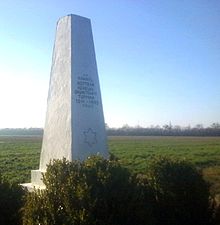The Holocaust in Brest District
| The Holocaust in the Brest District | |
|---|---|
 Monument to the murdered Jews - the founders of the ghetto in the village of Tamashowka, Brest district. Established in 1954. | |
| Location | Brest District |
| Date | 1941 to 1944 |

The Holocaust in Brest District refers to the systematic persecution and extermination of Jews in Brest District of Brest Region in Belarus by the occupying authorities of Nazi Germany and collaborators from 1941 to 1944 during World War II. This was part of the broader policy of the "Final Solution to the Jewish Question" an integral aspect of the Holocaust in Belarus and the broader genocide of European Jewry.[1]
Genocide of Jews in the District

Brest District was captured by German troops on June 22, 1941, and remained under Nazi occupation for more than three years, until the end of July 1944. The Nazis administratively included Brest District in the Brest-Litovsk District of the General District of Volhynia-Podolia within the Reichskommissariat Ukraine. All power in the district was held by the Sonderführer, the German head of the district, who was subordinate to the Gebietskommissar, the district commissioner. District (volost) administrations and police garrisons of collaborators were established in all major villages of the district. To enforce the policy of genocide and conduct punitive operations, SS punitive units, Einsatzgruppen, Sonderkommandos, the Secret Field Police (GFP), the Security Police and SD, the gendarmerie, and the Gestapo arrived in the district immediately after the troops.[2][3]
Simultaneously with the occupation, the Nazis and their accomplices began the total extermination of Jews. "Actions" (a term used by the Nazis to refer to the mass murders they organized) were repeated many times in various locations. In settlements where Jews were not killed immediately, they were kept in ghettos until their complete extermination and were used for heavy and dirty forced labor, which led to many deaths due to unbearable workloads, constant hunger, and lack of medical care.[4]
The occupation authorities, under threat of death, forbade Jews from removing yellow patches or six-pointed stars (identification marks on outer clothing), leaving the ghetto without special permission, changing their place of residence and apartment within the ghetto, walking on sidewalks, using public transport, being in parks and public places, and attending schools. Implementing the policy of Judenfrei, the Nazis made every effort to search for, capture, and kill even individual Jews. For example, a Jewish woman was tracked down, captured, and killed near the village of Mikhalin. By the end of 1942, Jews in Brest District had been almost completely exterminated. The most massive killings of Jews occurred in Brest, Domachevo, Tomashovka, Chernavchitsy, Lyshchytsy, and Motykaly.[2][3]
Ghettos
The Germans, implementing Hitler's program of exterminating Jews, created four ghettos in the district. In the Brest Ghetto (December 16, 1941 – October 18, 1942), up to 18,000 Jews were killed. In the Domachevo Ghetto (November 1, 1941 – September 20, 1942), about 2,500 Jews were killed. In the ghetto in Tamashowka (July 1942), more than 2,000 Jews were killed. In the Chernavchitsy Ghetto (summer 1941 – October 1942), about 1,000 Jews were killed.[5][6][7]
Ghetto in Lyshchytsy
In the village of Lyshchytsy, about 700 Jews remained before the occupation. In September (according to other sources, in August) 1942, the ghetto was liquidated, and all prisoners were shot. In 1956, an obelisk was erected on the mass grave.[8]
Cases of Rescue and "Righteous Among the Nations"
In Brest District, four people were awarded the honorary title of Righteous Among the Nations by the Israeli memorial institute Yad Vashem "in deep gratitude for the help provided to the Jewish people during World War II":
- Kuryanovich Ignaty – for saving Smolyar Moshe in Brest
- Golovchenko Petr and Sofya, and Makarenko Pelageya – for saving the Manker family and Engelman Misha in Brest
Memory
Incomplete lists of Jews killed in Brest District have been published. Monuments to the victims of the Jewish genocide have been erected in Brest, Domachevo, Tomashowka, Chernavchitsy, and Lyshchytsy.
See also
References
- ^ "Remains of Holocaust Victims Were Buried in Brest". Muzeum Getta Warszawskiego EN. Retrieved 2024-07-01.
- ^ a b "Remains of Holocaust Victims Were Buried in Brest". Muzeum Getta Warszawskiego EN. Retrieved 2024-07-01.
- ^ a b "The Jews of Pinsk, 1939-1943, Through the Prism of New Documentation". www.yadvashem.org. Retrieved 2024-07-01.
- ^ G. K. Kisyalev (eng. ed.), M. A. Korshak et al.. (ed.), V. M. Turkevich, L. A. Pavyalchuk (compilers). "Memory. Ivanovo District", "BELTA", 2000, - p. 167 ISBN 985-6302-23-4 (Belarusian)
- ^ "Memorialmuseums". www.memorialmuseums.org. Retrieved 2024-07-01.
- ^ Pszczółkowski, Michał (2014). "Architektura Brześcia nad Bugiem w latach II Rzeczypospolitej". Kwartalnik Architektury i Urbanistyki (in Polish and English). Vol. 59, no. 3. Translated by Pszczółkowska, Karolina. Komitet Architektury i Urbanistyki Polskiej Akademii Nauk. ISSN 0023-5865.
- ^ "Getto w Brześciu | Virtual Shtetl". 2020-09-19. Archived from the original on 2020-09-19. Retrieved 2024-07-01.
- ^ Holocaust on the territory of the USSR. Encyclopedia / See ed. I. A. Altman. — 2nd ed., ex. and add. — M.: ROSSPEN, 2011. — 1143 p. — ISBN 978-5-8243-1463-2.
